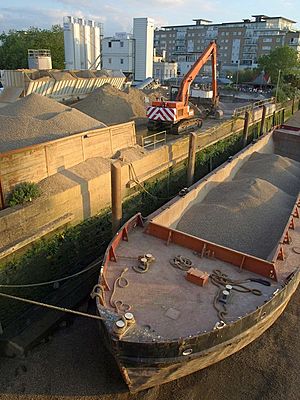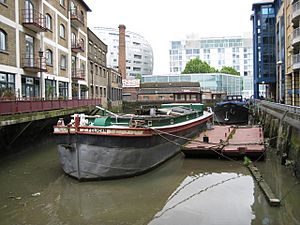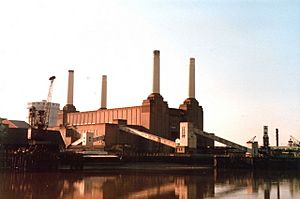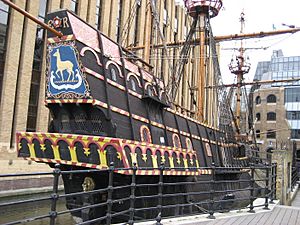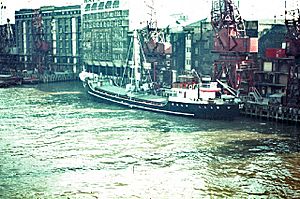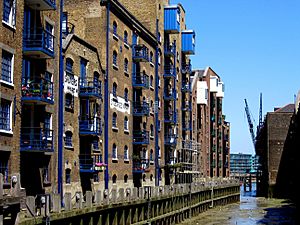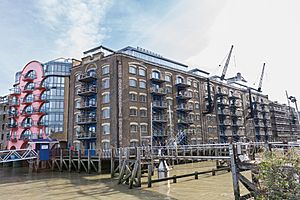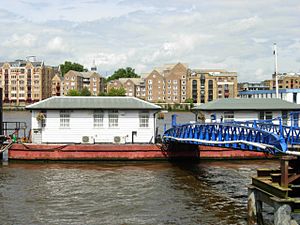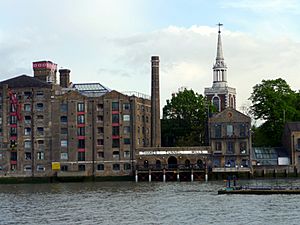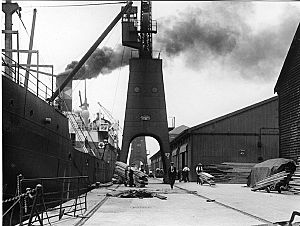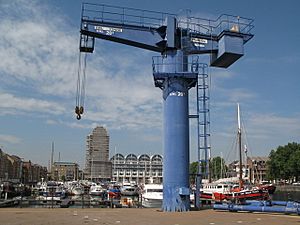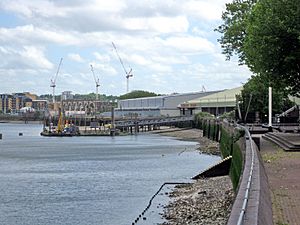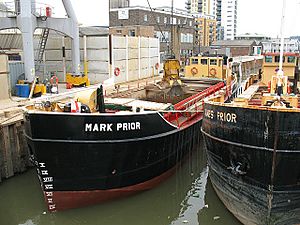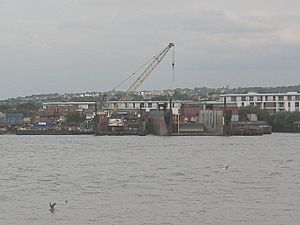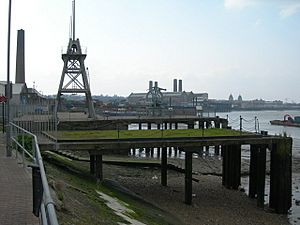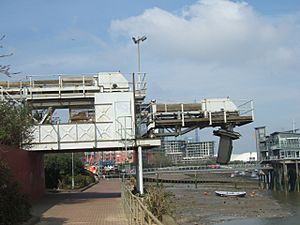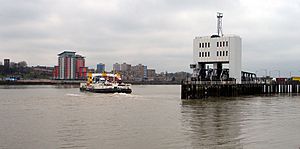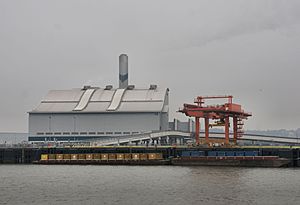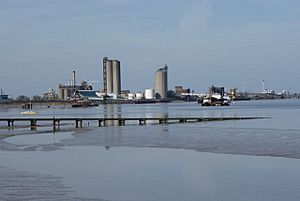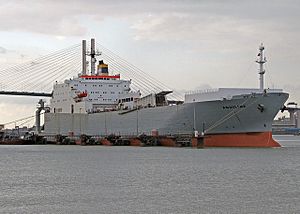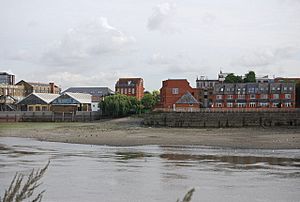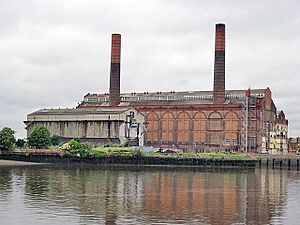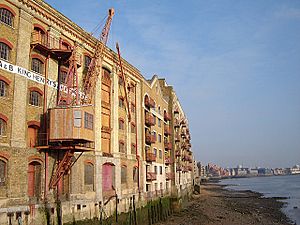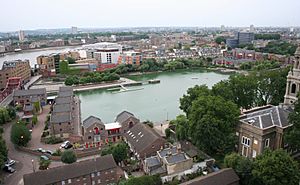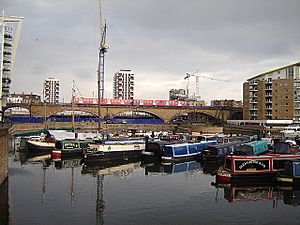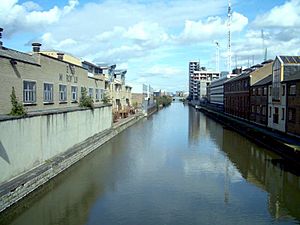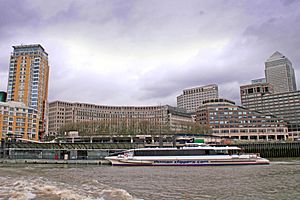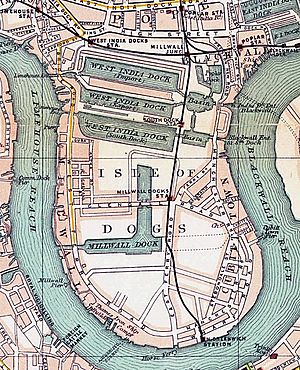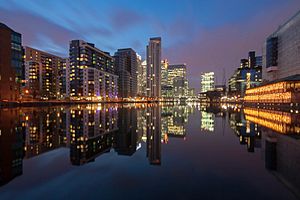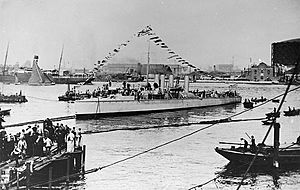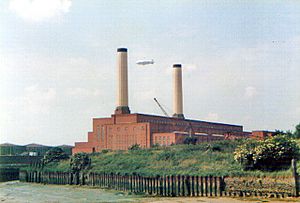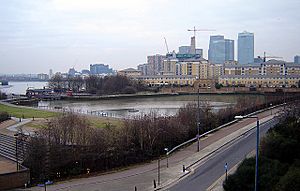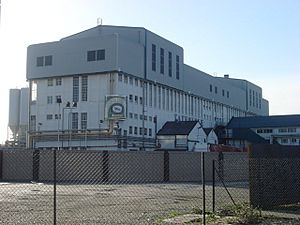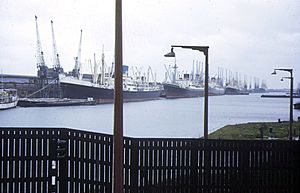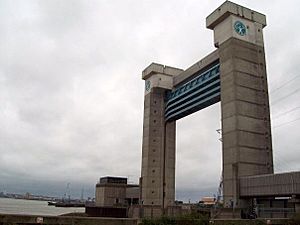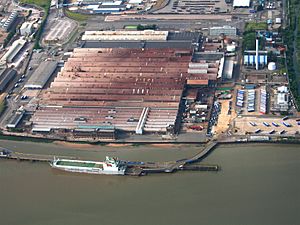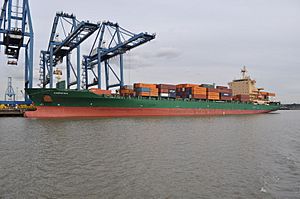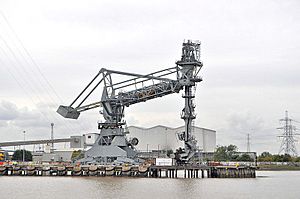List of locations in the Port of London facts for kids

The Port of London is a very old and important port on the River Thames in England. It includes many places where ships can load and unload goods, like wharves, docks, and piers. This article lists many of these places, from the ones furthest upstream (closer to the river's source) to those furthest downstream (closer to the sea).
Long ago, London's port was one of the busiest in the world! But things changed a lot when ships started using large metal boxes called containers to carry goods. This made many old docks close down and changed the jobs of dockers (people who loaded and unloaded ships).
Today, only about 70 active terminals are left, but they handle much more cargo than before. Most of the port's work now happens further down the Thames, outside of Greater London, in areas like Thurrock in Essex and north Kent. The Port of London Authority manages everything from its main office in Gravesend. The biggest container terminal is at Tilbury. A huge new project called London Gateway is also being built, which will become the largest part of the Port of London when it's finished.
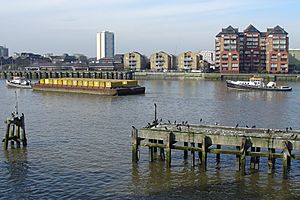
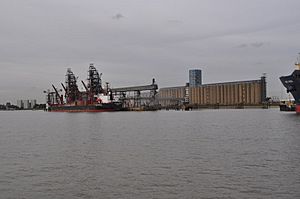
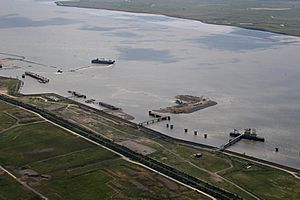
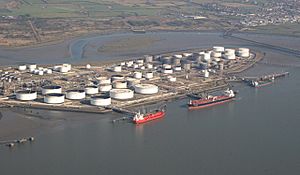
Contents
- What are Wharves and Docks?
- Exploring the South Bank of the Thames
- Exploring the North Bank of the Thames
- Isleworth to Hammersmith
- Fulham and Chelsea's Industrial Past
- Westminster and the City of London
- Upper Pool and Wapping
- Stepney, Limehouse, and Millwall
- Cubitt Town and Blackwall
- Canning Town and Silvertown
- North Woolwich and Beckton
- Barking Creek and Dagenham Dock
- Rainham to Tilbury
- Shell Haven and Southend
What are Wharves and Docks?
Wharves and docks are special places along a river or coast where ships can safely tie up. They allow goods to be moved on and off the ships.
- A wharf is usually a flat area built alongside the water.
- A dock is often an enclosed area of water, sometimes with gates, where ships can stay afloat even when the tide goes out.
- A pier is a structure built out over the water, often used for smaller boats or for people to get on and off ferries.
Some of the places listed here are marked with a †. This means they are "safeguarded wharves," which means they are protected for future port use. Places marked in italics are no longer used for shipping or river activities.
Exploring the South Bank of the Thames
Let's take a journey down the south side of the River Thames, exploring some of the important wharves and docks.
From Kew to Putney
The journey begins in Kew, a leafy area known for its famous gardens.
- Kew Gardens Pier is a well-known spot here.
Moving downstream, we reach Mortlake and Barnes.
- The Stag Brewery once had its own wharf.
- Mortlake Power Station also had a site here.
- Putney Pier is a busy stop for TfL river boats. Many other wharves were also located here.
Wandsworth and Battersea's Busy Past
In Wandsworth, the River Wandle joins the Thames.
- Western Riverside is a modern site for transferring solid waste.
- Wandsworth Riverside Quarter Pier is another TfL river boat stop.
- Pier Wharf is an important safeguarded wharf.
Battersea was once a very industrial area.
- Plantation Wharf was where sugar was handled.
- The famous Battersea Power Station had a special pier for coal.
- Ransomes Dock and Cringle Dock are still used for moving goods. Many other wharves were found along this stretch.
Vauxhall, Lambeth, and Southwark's Historic Wharves
Near Vauxhall and Lambeth, many wharves once lined the river.
- Middle Wharf is used by Cemex, a building materials company.
- Lambeth Pier is a well-known spot.
- Waterloo Millennium Pier is a popular stop for river services, near County Hall.
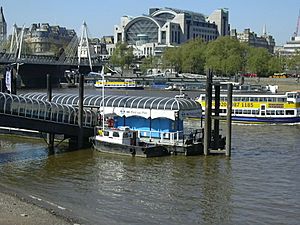
Southwark has a rich history.
- Festival Pier is another busy TfL river service stop.
- The Old Shot Tower Wharf was once home to a tower where lead shot was made.
- The former Bankside Power Station is now the Tate Modern art gallery.
- Bankside Pier is a river service jetty.
- St Mary Overie Dock is famous for being where the replica ship The Golden Hind is moored. Many other wharves were here, including Jamaica Wharf and Phoenix Wharf.
The Upper Pool and Bermondsey
The Pool of London is a historic part of the Thames.
- London Bridge City Pier is a modern pier near Hay's Dock.
- Hay's Dock and Wharf was once a huge warehouse complex.
- Billingsgate Market and Custom House Wharf were key trading points.
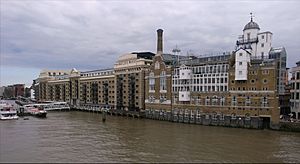
Bermondsey was a very important area for docks.
- The Anchor Brewhouse and Butler's Wharf are now famous buildings.
- Shad Thames is a historic street with many old warehouses.
- St Saviour's Dock was once a busy dock.
- Cherry Garden Pier is a small pier in Bermondsey. Many other wharves like Newell's Wharf and Brunswick Wharf were found here.
Rotherhithe's Docklands History
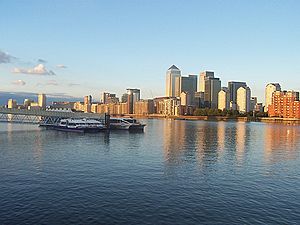
Rotherhithe was home to the huge Surrey Commercial Docks.
- Thames Tunnel Mills was a large industrial site.
- The Rotherhithe Tunnel runs under the river here.
- The Surrey Commercial Docks were once massive, but are now mostly filled in and redeveloped.
- Greenland Dock is one of the largest remaining docks.
- Greenland Dock Pier and South Dock Marina are still active. Many other wharves like Canada Wharf and Odessa Wharf were part of this area.
Deptford and Greenwich's Maritime Past
Deptford has a long history with the Royal Navy.
- Convoy's Wharf was once a Royal Navy supply depot.
- Brewery Wharf is an active site for moving aggregates (like sand and gravel). The Royal Victoria Victualling Yard was also located here.
Greenwich is famous for its maritime history.
- Greenwich foot tunnel goes under the river.
- Greenwich Pier is a major stop for TfL river services.
- The former Royal Naval College and National Maritime Museum are here.
- Greenwich Power Station also had its own wharf. Badcock's Wharves are still used for boat dry docking.
Greenwich Peninsula and New Charlton
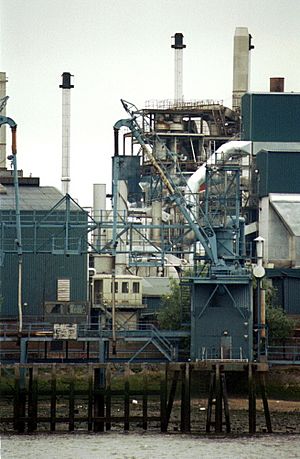
The Greenwich Peninsula is a modern area.
- Enderby's Wharf was once a rope factory and later made submarine cables.
- Tunnel Glucose is a large factory that still uses the river.
- Victoria Deep Water Terminal is a busy site for aggregates.
- The Blackwall Tunnel runs under the river here.
- Queen Elizabeth II Pier is a TfL river service stop.
New Charlton is home to important industrial sites.
- Angerstein Wharf is a major aggregates wharf with a rail connection.
- Murphy's Wharf is another large aggregates terminal.
- Cory's Barge Works builds and repairs barges.
- Barrier Gardens Pier is used by the Port of London Authority.
- The impressive Thames Barrier protects London from floods.
Woolwich to Gravesend
Woolwich has a strong military history.
- The Woolwich Dockyard was a very important shipbuilding site for the Royal Navy.
- The Woolwich Free Ferry carries cars and people across the river.
- Woolwich Arsenal Pier is a TfL river service stop.
Further downstream, we find Belvedere and Erith.
- The Belvedere Incinerator burns waste and has a wharf for refuse barges.
- ADM Erith is a large oil seed mill.
- Erith Pier has been rebuilt for leisure use.
Dartford and Greenhithe are important for freight.
- The River Darent joins the Thames here.
- The Dartford Crossing (tunnels and bridge) crosses the river.
- Thames Europort and CdMR Dartford are busy terminals for "ro-ro" (roll-on/roll-off) ferries, which carry vehicles.
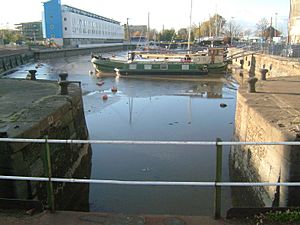
Finally, we reach Northfleet and Gravesend.
- Seacon Terminals Tower Wharf handles steel and wood products.
- Northfleet Terminal is used by Kimberly-Clark (a paper products company).
- The Gravesend–Tilbury Ferry connects the two banks.
- Royal Terrace Pier is where the Port of London Authority has its headquarters.
- The Gravesend Canal Basin is being restored.
- Denton Wharf and Jetty is the main base for PLA vessels.
Cliffe and Beyond
In Cliffe, the North Sea Terminal handles sea-dredged aggregates.
- Lower Hope Point is a significant landmark.
- Yantlet Creek marks a boundary.
Beyond this point, the Medway ports, like Thamesport and Sheerness, are not considered part of the Port of London.
Exploring the North Bank of the Thames
Now, let's look at the north side of the River Thames, moving downstream.
Isleworth to Hammersmith
In Isleworth, there were once several wharves like Lion Wharf and Town Wharf.
Brentford and Strand-on-the-Green were important transport hubs.
- Brentford Dock was a major point where goods were transferred between the river and the Great Western Railway.
- The River Brent and Grand Union Canal join the Thames here.
Chiswick is a scenic area.
- Chiswick Pier is a popular spot.
- Church Wharf was where Thornycroft built his first torpedo boats.
- The famous Fuller's Griffin Brewery also had a wharf.
Hammersmith has a well-known bridge.
- Many wharves like Albert Wharf and Hope Wharf once lined the river here.
- Gwynne's Wharf was a notable industrial site.
Fulham and Chelsea's Industrial Past
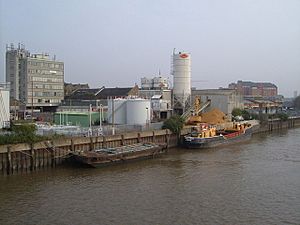
Fulham and Sands End were busy industrial areas.
- Distillery Wharf was home to a Haig distillery.
- Duckham's Wharf was where motor oil was made.
- Thames Wharf is now a famous architectural studio.
- Hurlingham Wharf, Swedish Wharf, and Comley's Wharf are still safeguarded.
- Chelsea Harbour Pier is a TfL river service stop.
- Chelsea Harbour marina was once Chelsea Basin.
In Chelsea, the Lots Road Power Station was a huge landmark.
- Cremorne Wharf is a safeguarded wharf.
- Cadogan Pier is a TfL river service stop.
Westminster and the City of London
Westminster and the City of London are at the heart of London.
- The Grosvenor Canal once connected to the Thames.
- Millbank Millennium Pier and Westminster Millennium Pier are busy TfL river service stops.
- The PS Tattershall Castle and RS Hispaniola are permanently moored boats.
- Embankment Pier, Savoy Pier, and Temple Pier are other important piers.
- HMS President is a ship used by the Royal Naval Reserve.
- Blackfriars Millennium Pier is another TfL river service stop.
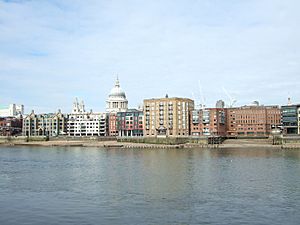
The City of London has ancient wharves.
- Puddle Dock and Queenhithe Dock are very old dock sites.
- Walbrook Wharf is a modern waste transfer station.
- Dyers' Hall Wharf and Old Swan Pier are historic sites.
Upper Pool and Wapping
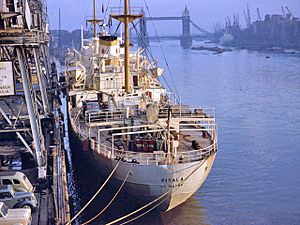
The Upper Pool is a very historic part of the Thames.
- Fresh Wharf and Cox and Hammond's Wharf were once major trading points.
- Billingsgate Market and Custom House Wharf were key trading points.
- Tower Millennium Pier is a busy pier near Tower Bridge.
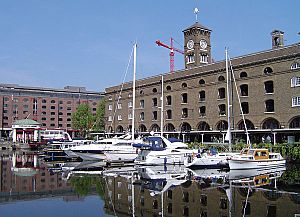
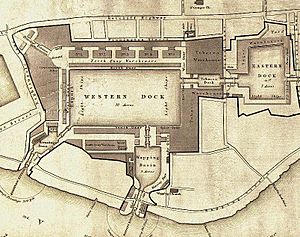
Wapping and Shadwell were once filled with docks.
- St Katharine Docks are now a popular marina and leisure area.
- Tower Bridge Quay is a TfL river service stop.
- HMS President is a naval training base.
- The London Docks were a huge system of docks, now mostly redeveloped.
- King Henry's Wharves and New Crane Wharves are historic sites.
- Shadwell Basin was part of the London Docks.
Stepney, Limehouse, and Millwall
Stepney (formerly Ratcliff) and Limehouse were important for trade.
- Free Trade Wharf was a significant trading point.
- The entrance to Limehouse Basin (formerly Regent's Canal Dock) connects to the canal system.
- The Limehouse Cut is another canal that joins the Thames here.
- Stepney Power Station once stood at Blyth Wharf.
- Limehouse Pier is a local pier.
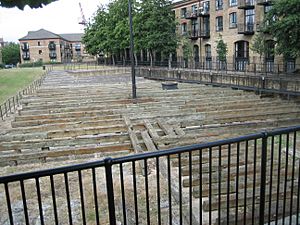
Millwall is part of the Isle of Dogs, famous for its docks.
- The West India Docks were once massive docks for goods from the West Indies.
- Canary Wharf Pier is a busy stop for river services, serving the modern financial district.
- The Millwall Dock was another large dock system.
- The SS Great Eastern was a giant ship built here, and its launch ramp is still visible.
- Masthouse Terrace Pier is a modern pier.
- Burrell's Wharf was once a paint factory.
Cubitt Town and Blackwall
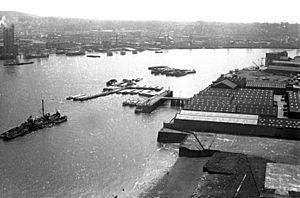
Cubitt Town was home to many shipyards.
- Dudgeon's Wharf was a shipbuilding yard.
- London Yard was a famous shipyard where ships like those built by Yarrows were made.
- The Samuda Brothers also had a shipyard here.
- The entrance to the West India Docks is located here.
Blackwall and Leamouth are at the mouth of the Bow Creek.
- The entrance to Poplar Dock and the West India Docks is here.
- Northumberland Wharf is now a waste transfer station.
- The Blackwall Yard was a historic shipbuilding site.
- Brunswick Wharf Power Station was a large power plant.
- The entrance to the East India Docks is also here.
- Trinity Buoy Wharf is a unique site for arts and creative industries.
Canning Town and Silvertown
Canning Town was home to a massive ironworks.
- The Thames Ironworks and Shipbuilding Company built many famous ships here.
- Priors Wharf and Mayer Parry Wharf are active sites on the Lower Lea Valley/Bow Creek.
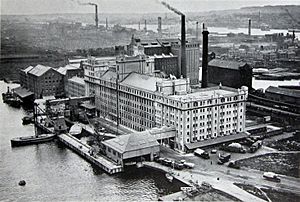
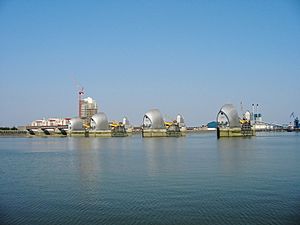
Silvertown is known for its food processing industries.
- Plaistow Wharf is home to the Tate & Lyle Golden Syrup works.
- Royal Primrose Wharf was once a soap factory.
- Sunshine Wharf is a safeguarded wharf.
- The Silvertown explosion happened at Crescent Wharf in 1917.
- The northern end of the Thames Barrier is located here.
- Tate & Lyle Thames Refinery is a very large sugar refinery with its own jetty.
North Woolwich and Beckton
North Woolwich was important for cable manufacturing.
- Western Electric Co's and W.T. Henley's cable works were here.
- The Woolwich Free Ferry north pier is located here.
- The Woolwich foot tunnel also goes under the river.
- The entrance to the Royal Docks is still used for boat exhibitions.
Beckton was famous for its gas works.
- Gallions Jetty was used by Cory & Son.
- The Beckton Gas Works were once the largest in the world.
Barking Creek and Dagenham Dock
Barking Creek is the lower section of the River Roding.
- Welbeck Wharf, Pinns Wharf, and Debden Wharf are active sites.
- The Barking Creek tidal barrier helps control water levels.
Dagenham Dock is a major industrial area.
- RMC Roadstone and White Mountain Roadstone handle aggregates.
- Thunderer Jetty handles petrol, aviation fuel, and other liquids.
- Stolthaven Dagenham stores fuels and oils.
- Ford Dagenham Terminal is a huge terminal for the Ford car factory.
Rainham to Tilbury
Rainham has industrial sites.
- Phoenix Wharf/Frog Island is a safeguarded wharf.
- Tilda Rice has a wharf here.
- Veolia has a jetty for its landfill site.
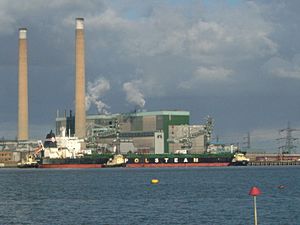
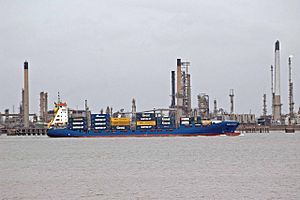
Purfleet is home to major oil and ferry terminals.
- The Mar Dyke joins the Thames here.
- Esso - ExxonMobil handles petroleum products.
- CLdN Purfleet operates large RO-RO ferries.
- Jurgen's Jetty and Van den Bergh Jetty handle edible oils.
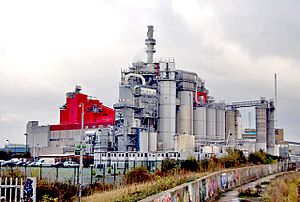
West Thurrock and Grays are important industrial areas.
- Lafarge Jetty handles aggregates.
- Navigator Terminals Ltd. stores various liquid chemicals and oils.
- West Thurrock Jetty handles chemicals.
- Procter & Gamble has a large detergent works here.
- Nustar Grays Terminal stores fuels.
Tilbury is home to the main dock system of the Port of London.
- Tilbury Grain Terminal handles cereals.
- Northfleet Hope Terminal is a major container terminal.
- Tilbury Ness is a point on the river.
- London International Cruise Terminal, Tilbury, welcomes cruise ships.
- Tilbury 2 is a new roll-on/roll-off terminal.
- Mucking wharf handles refuse.
Shell Haven and Southend
Shell Haven, Coryton, Canvey Island, and Southend are the furthest downstream.
- London Gateway port is a massive new container port, built on the site of the former Shell Haven oil refinery.
- Thames Oilport was formerly Coryton Refinery.
- Oikos Storage on Canvey Island stores oil.
- Calor Gas Terminal is also on Canvey Island.
- Billet wharf and Bell wharf in Leigh-on-Sea are used for shellfish.
- Crow Stone, Southend marks the former seaward limit of the Port of London.
- Southend Pier is a very long pier for visitors.


